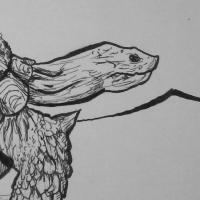Chroil Lily
Before the wide spread use of rune casting, the Chroli Lily was coveted for its healing properties and many rulers tried various means of getting the lily to grow within their own borders with various level of success. Now that rune casting is the preferred method of healing by a majority of the world, only the island nation of Kimiri and poorer countries continue to use this flower frequently.
Basic Information
Anatomy
The Chroil Lilies are some of the most eye-catching and flamboyant flowers in all of Iosis. The flower itself is huge and its petals area gradient going from a bright crimson nearest the stem to pink and finally to white at the tip. A strong honeyed fragrance drifts up from these blooms making them ideal for use as decoration in homes or in perfumes. The flower is in the shape of a bowl and is made up of six petals.
Growth Rate & Stages
Bulb: Before the beautiful flower blossoms, the Chroil Lily is a seed that grows into a bulb with roots emerging from the bottom and covered in a scaly membranous material.
Sprout: If the bulb is happy with the soil its planted in, the roots will begin to grow larger, and a new shoot will emerge from the top eventually breaking through topside. It usually takes a few days for these small green shoots to appear depending on how far down they've been planted in the ground.
Growth: During the next thirty to forty days, the shoot grows taller and thicker while buds and leaves begin showing on on the stem.
Bloom: Thirty to forty-five days after the lily begins to grow, the Chroil Lily finally blooms. At this stage, the plant has reached its maximum height and will bloom for two to three weeks during the summer months. Each stalk can have up to ten lilies. It is during this stage, the flowers disperse its seeds and pollen and begin the germination process for a brand new bulb.
Death:The bloom will begin falling apart two to three week after it opened but, the stem will remain standing tall until autumn when it will start browning and will collapse under its weight.
Re-Birth: So long as the bulb is not heavily damaged, been eaten, or succumbed to rot, it will survive the winter months and come summer will start the cycle all over again.
Ecology and Habitats
These flowers need either full sun or partial shade, plenty of fresh water and soil enriched by the minerals and ash distributed by volcanoes. Despite how picky the Chroil Lily is about soil composition, it does not mind if there are other flowers or plants nearby.
Dietary Needs and Habits
Like all plants, the Chroil Lily needs lots of fresh water, sunlight and rich soil to bloom. However, this lily is incredibly temperamental and tends to only prefer the incredibly rich soil found on volcanic islands. In any other soil, no matter how rich or well maintained, the bulbs will refuse to grow and any lily transported after its flowered will wither and die.
Additional Information
Uses, Products & Exploitation
The bulb when ground up or left as is, is incredibly poisonous and if ingested or gets into a person's system some other way will cause a very painful death. The leaves and petals of the lily have a large number of medicinal purposes when dried and ground up including easing difficult pregnancies, preventing jaundice in newborns, working as an antiseptic, working a pain reliever and finally working an anti-inflammatory. The flowers can also be used as decoration or dried up and used to make potpourri.
Geographic Origin and Distribution
Kimiri
Scientific Name
Anceps lilium
Lifespan
The flowers will only bloom for 2-3 weeks. The bulbs themselves will last for a few years before beginning to rot.
Average Height
3-6 feet
Average Weight
12 ounces (most of this weight is the bulb)
Average Length
The flowering part of the lily is three inches wide.
The entire plant, including its stem and non-flowering leaves, has a spread of about a foot.






I like the very detailed growth stages and the subtle "how to properly tend to the plant" instructions there ^^
Can you tell I've planted lilies before? XD